
Camassia quamash, commonly known as camas, small camas, common camas, common camash or quamash, is a perennial herb. It is native to western North America in large areas of southern Canada and the northwestern United States.

Phacelia fremontii is a flowering plant in the family Boraginaceae native to the southwestern United States. In California, its range includes the Mojave Desert, the San Joaquin Valley, the Coast Ranges, and the Sierra Nevada. It was named for John C. Frémont.
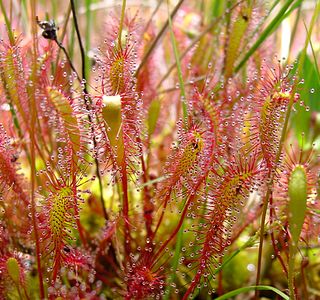
Drosera anglica, commonly known as the English sundew or great sundew, is a carnivorous flowering plant species belonging to the sundew family Droseraceae. It is a temperate species with a circumboreal range, although it does occur as far south as Japan, southern Europe, and the island of Kauai in Hawaii, where it grows as a tropical sundew. It is thought to originate from an amphidiploid hybrid of D. rotundifolia and D. linearis, meaning that a sterile hybrid between these two species doubled its chromosomes to produce fertile progeny which stabilized into the current D. anglica.
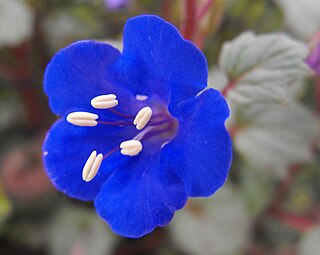
Phacelia campanularia is a species of flowering plant in the borage family, Boraginaceae, known by the common names desertbells, desert bluebells, California-bluebell, desert scorpionweed, and desert Canterbury bells. Its true native range is within the borders of California, in the Mojave and Sonoran Deserts, but it is commonly cultivated as an ornamental plant and it can be found growing elsewhere as an introduced species.
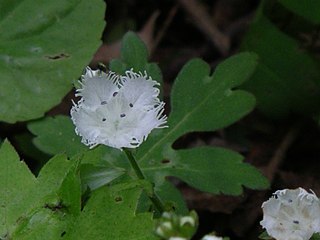
Phacelia fimbriata, the fringed phacelia, is a spring flowering wildflower of the genus Phacelia found in the highland woods of southeastern United States including the Great Smoky Mountains.
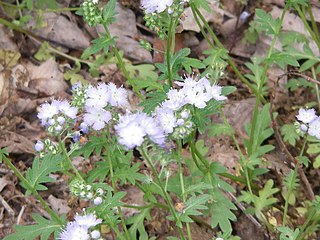
Phacelia purshii, known by the common names Miami mist, scorpionweed, and purple scorpionweed, is a spring flowering annual forb with blue, lavender, violet, or nearly white flowers in the Boraginaceae (borage) family that is native to eastern and central North America.

Oenothera suffrutescens is a species of flowering plant in the evening primrose family known as scarlet beeblossom and scarlet gaura.

Sambucus racemosa is a species of elderberry known by the common names red elderberry and red-berried elder.

Phacelia sericea, the silky phacelia or blue alpine phacelia, is a showy perennial species of Phacelia endemic to western North America. It grows mainly at subalpine to alpine elevations in forest openings or above treeline among rocks and sand. Sericea comes from the Latin sericeus, or silky, referring to the fine hairs on the leaves and stem.

Drosera linearis, commonly called the slenderleaf sundew, is a sundew found in the Great Lakes region of North America, in Canada and the United States, such as Michigan, and in Montana. It is usually no more than four inches tall.

Lythrum portula is a species of flowering plant in the loosestrife family known by the common names water-purslane and spatulaleaf loosestrife. It is native to Europe, and it is found in parts of western North America as an introduced species. It often grows in moist habitat, such as marshes. This is a prostrate annual herb producing a hairless, reddish stem up to 25 centimeters long which lies along the ground and roots where its nodes come in contact with wet earth. The slightly fleshy, spoon-shaped leaves are about a centimeter long and greenish to reddish in color. Solitary flowers occur in leaf axils. Flowers often have white or pink petals about a millimeter long, but some lack petals. The fruit is a spherical capsule containing minute seeds.
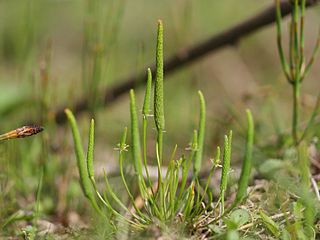
Myosurus minimus is a species of flowering plant in the family Ranunculaceae known by the common name tiny mousetail or just mousetail. It is native to much of the Northern Hemisphere, including parts of Europe, Asia, North Africa, and North America. It generally grows in moist habitat types, such as riverbanks and wet meadows.
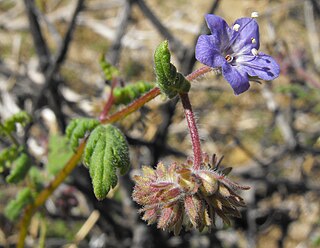
Phacelia distans is a species of flowering plant in the borage family, Boraginaceae, known by the common names distant phacelia and distant scorpionweed. It is native to the southwestern United States and northwestern Mexico, where it grows in many types of habitat, including forest, woodland, chaparral, grassland, and meadows.

Phacelia hastata is a species of flowering plant in the borage family, Boraginaceae. Its common names include silverleaf scorpionweed, silverleaf phacelia, and white-leaf phacelia. It is native to western North America from British Columbia and Alberta south to California and east to Nebraska. It can be found in many types of habitat, including scrub, woodland, and forest, up to an elevation of 13,000 feet. It prefers sandy to rocky soil.
Phacelia inundata is a species of phacelia known by the common names playa yellow phacelia and playa phacelia. It is native to the Modoc Plateau and surrounding areas in Oregon, western Nevada, and northeastern California, where it grows in the alkaline soils of playas and dry lakebeds.

Phacelia pringlei is a species of flowering plant in the borage family known by the common name Pringle's phacelia. It is endemic to far northern California, where it is known only from the southern Klamath Mountains. It grows in coniferous forest and open mountain slopes.

Phacelia ramosissima is a species of phacelia known by the common name branching phacelia. It is native to western North America from British Columbia to California and the Southwestern United States, where it can be found in many types of habitat.

Phacelia viscida is a species of phacelia known by the common names sticky phacelia and tacky phacelia.
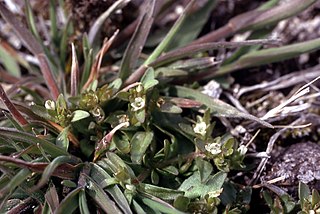
Plagiobothrys scouleri is a common species of flowering plant in the borage family known by the common name Scouler's popcornflower and white forget-me-not. It is native to North America, where it can be found from Alaska throughout southern Canada and the western and central United States. It is present in the United Kingdom as an occasional introduced species.

Erigeron speciosus is a widespread North American species of flowering plants in the family Asteraceae known by the common names aspen fleabane, garden fleabane, and showy fleabane.



















